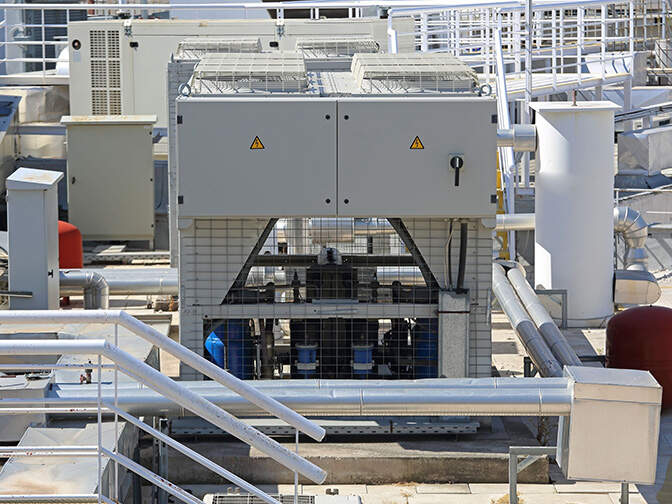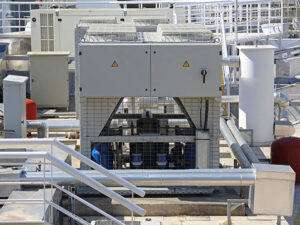Comfort and health have become essential factors in building occupancy and that is why building owners are specific with their requirements for an HVAC unit. To manage a project that requires HVAC, project managers should be keener in screening their HVAC subcontractor’s choice of HVAC unit to meet the client’s requirements. But with the influence of modernization on the HVAC industry, it can be a challenge to spot the right type of system. The goal, though, is always achieving an energy-efficient and cost-effective HVAC solution. And central air conditioning systems have been one of the top choices of most construction companies and clients.
What is a Central Air Conditioning System?
There are various types of HVAC units to choose from but centralized air conditioners are becoming a top option in buildings as they have considerable advantages that other units can’t deliver.
Central air conditioners work by circulating cool air inside a building through its series of ducts. The supply ducts are responsible for carrying the already cooled air from the unit back to the building. On the other hand, the return duct is the one collecting air to be cooled down inside the unit. These processes then become a cycle.
A central air conditioning unit is classified into three main groups:
1. All-air systems: This type of unit uses air as a working fluid for both heating and cooling
2. All-water systems: This type of unit uses water as a working fluid for both heating and cooling
3. Air-water systems: This system uses both air and water for heating and cooling the building
The choice you make depends on the fluid you want to use on your system. Air is abundant in any place but when it is too warm in your area, cooling takes a bit of a challenge. The better option, then, is the all-water systems. But when you have a better climate, using an all-air system or air-water system will be a great choice.
Tips for Upgrading to Central Air Conditioner
In your building projects, note that installing a central air conditioner is more efficient than using smaller or room air conditioning units. They are more cost-efficient to use as they can cool and heat a larger space, needing lesser buying, installation, and maintenance costs. To save on money, you have to shop for the most modern units, though, as they feature the latest energy-saving technologies. However, the ductwork is what you need to take into consideration when planning your project. Set a meeting with your subcontractors to plan the work sequence and have them posted through your construction schedule software.As we mentioned before, some tasks are interdependent, like the HVAC, electrical, and plumbing works. So have these stakeholders meet to know the right timing to install your central air conditioning unit.
Meanwhile, when you already have a central air conditioner installed, but it’s time for an upgrade, you may need to replace the outdoor compressor too so that the system will be truly efficient. But before buying a compressor on your own, it would be a good practice to consult an HVAC subcontractor to ensure that the compressor matches the new HVAC unit you buy.
The best-centralized HVAC systems today consume 30% to 50% lesser energy than the older models. So, by replacing the 1970s models with the new ones, you will be able to save up to 40% of energy costs.
When scheduling a construction project and you are meeting with your HVAC subcontractor, have them study your building plan through BIM so they can define the proper sizing and installation strategy. These serve as the key elements in determining the efficiency of your HVAC unit. Have them document results on your project management software and share them with your clients. This is necessary because, oftentimes, clients think that a larger unit will be more adequate in supplying a comfortable temperature or removing humidity. But the truth is that the efficiency of the system depends on the following factors:
· Improper unit location
· Improper duct installation
· Lack of insulation
· Wrong choice of unit
It is important to note that when buying a central HVAC system, you have to check on the SEER or seasonal energy efficiency ratio, which determines the relative amount of energy used by the unit to produce a cooling effect. If it has a SEER of 6 or lower, that means that the unit is old and less efficient. So, to save more on costs, look for a unit with a SEER that’s greater than the standard rating.
Additionally, you should check the HVAC unit for EnergyGuide labels and ENERGY STAR® to know that it complies with modern standards. Good centralized HVAC units should have about 15% more efficiency rating than standard models.
While we recommend upgrading old HVAC units, the lifespan of your system should be about 15-20 years. Discuss with your HVAC subcontractor whether they will provide repair and maintenance services within that span of time. This should be discussed during the bidding and should be included in your subcontractor’s contract. Also, check with the HVAC unit manufacturer whether they have a warranty for the parts or the whole unit.
Other features you have to look for when buying a central HVAC unit include:
· EER or High-temperature rating and thermal expansion valve rating that’s higher than 11.6 so it can operate efficiently during the hottest summer day.
· Quiet operation so that occupants can have a better focus on their activities inside the building
· Air handler with variable speed
· Unit with fan-only option so the building owner and occupants can save on air-conditioning costs during the cooler days
· Filter check alerts to remind the building owner and occupants when it’s time to change the filter. This is to maintain the circulation of clean air inside the building.
· Automatic-delay fan switch so occupants have time to exit the building with a desirable air temperature even after the compressor is turned off.
With these tips and the help of your HVAC subcontractor’s expertise, you are now ready to pick the perfect central HVAC system to use in your construction building project.
Top 5 Central Air Conditioning Units in the US
1. Lennox Signature Series XC25
The best in this list is designed and manufactured by Lennox. Its Signature Series is committed to providing higher air and energy efficiency than any other HVAC units in this list by eliminating the use of fossil fuels.
The XC25 serves as the Signature Series flagship, which uses a split system type of central air conditioning unit. It has a SEER rating of 26, which only proves how highly efficient it is. It can cut energy costs up to 50 or 60 percent.
2. Daikin DX20VC and Amana AVXC20
Tied at the number 2 spot are Daikin and Amana, which are now under the same company. Daikin acquired Amana some years ago but since the latter has already established a good reputation in the HVAC market, Daikin opted to continue using the brand name.
Daikin’s two models surpassed Lennox when it comes to SEER rating and feature variable-capacity type of air conditioners, which are similar to variable-speed, modulating, and inverter-driven ACs.
3. Carrier Infinity 21 24ANB1 and Bryant Evolution180B
Another duo in this list is the Carrier Infinity 21 24ANB1 and Bryant Evolution 180B. Bryant is an independent brand owned by Carrier and are champions in EER. That means that they are the perfect workhorses for the summer season.
Among the brands in this list, Carrier is the most popular one and is greatly recommended by HVAC subcontractors for both home and building owners. The units use two-stage type ACs, which are far from the variable type that they made popular.
A two-stage AC conditions the air in either low or high, where low cooling uses only 70% capacity and is recommended for maintaining even temperatures while high cooling uses 100% capacity to speed up the cooling process.
4. York YXV
York is a brand under Johnson Controls along with other brands like Coleman and Fraser. Among the three, though, York is the most widely sold in the different regions of the U.S.
This variable-capacity HVAC unit has a climate adjustment function to achieve optimal energy efficiency while making the inside of the building comfortable. Installers can adjust the unit to dry, humid, or normal climate.
Another Japanese brand that makes it to this list is Rheem Prestige RA20 by Paloma Industries. It is a variable-capacity unit that was introduced in the mid of 2019.
Rheem offers 10-year unit replacement, making it a top choice for project managers who think beyond the construction phase. So when a part fails during the allotted period, you can have the whole unit changed by Paloma.
Another notable feature about Rheem Prestige RA20 is that it uses a Copeland Compressor, which is also used by other HVAC brands like Carrier, Amana, Arocaire, and Goodman, among many others.
Final Thoughts
Most HVAC subcontractor’s recommendations will be using a single or two-stage air conditioning system rather than the above-mentioned units even if they are high-performing units. That’s because these central HVAC systems require higher buying and installation costs. Another reason is their greater potential for mechanical failure. That said, maintenance and repair should be a part of your agreement with your HVAC subcontractor.
Although single-stage and two-stage ACs are better for warmer regions of the country when your priority is using the latest HVAC technology or greener cooling, the central AC units we listed above are the best options you’ll have.
HVAC is an important component of any building project. So, before starting construction, contractors should be able to find the right team to hire and have them connected with other stakeholders through project management software so that their work results are in compliance with the project team’s schedule and the client’s requirements. This way, a contractor is ensured to achieve an optimal HVAC installation.





